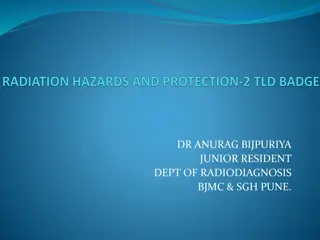Quantitative Imaging and Dosimetry for Radiopharmaceutical Therapy Planning
This presentation highlights the importance of quantitative imaging and dosimetry in planning radiopharmaceutical therapy. It emphasizes the need for individualized dosimetry to tailor treatment procedures and verify the absorbed dose delivered. The content discusses the framework provided for treatment planning and dose verification, essential for optimizing therapy outcomes. Additionally, it references key publications and recommendations from the International Commission on Radiological Protection (ICRP) related to therapy with radiopharmaceuticals.
Download Presentation

Please find below an Image/Link to download the presentation.
The content on the website is provided AS IS for your information and personal use only. It may not be sold, licensed, or shared on other websites without obtaining consent from the author.If you encounter any issues during the download, it is possible that the publisher has removed the file from their server.
You are allowed to download the files provided on this website for personal or commercial use, subject to the condition that they are used lawfully. All files are the property of their respective owners.
The content on the website is provided AS IS for your information and personal use only. It may not be sold, licensed, or shared on other websites without obtaining consent from the author.
E N D
Presentation Transcript
ICRP Publication 140 Authors on behalf of ICRP Y. Yonekura, S. Mattsson, G. Flux, W.E. Bolch, L.T. Dauer, D.R. Fisher, M. Lassmann, S. Palm, M. Hosono, M. Doruff, C. Divgi, P. Zanzonico
This slide set copies information from ICRP Publication 140 in Main Points and Recommendations as well as in other key descriptions. Readers of this slide set are advised to go through the full publication for detailed information as this material is only a glimpse, rather than a comprehensive presentation of its contents. 4
1. INTRODUCTION 2. RADIOPHARMACEUTICAL THERAPY METHODS: JUSTIFICATION AND OPTIMISATION 3. BIOKINETIC DATA COLLECTION 4. METHODS FOR ABSORBED DOSE CALCULATIONS 5. SPECIFIC RADIOLOGICAL PROTECTION ISSUES 6. SUMMARY OF RECOMMENDATIONS 5
Quantitative imaging and dosimetry should be the basis for treatment planning for radiopharmaceutical therapy, just as they are for external-beam radiotherapy. This publication details a framework to perform individualised dosimetry to plan radiopharmaceutical therapy procedures and to verify the absorbed dose delivered. 6
Current ICRP Recommendations related to Therapy with Radiopharmaceuticals Publications 73 (ICRP, 1996a) Publication 94 (ICRP, 2004) Publication 103 (ICRP, 2007a) Publication 105 (ICRP, 2007b) 7
Treatment with radiopharmaceuticals requires administration protocols that justify and optimise the treatment. Individual absorbed dose estimates should be performed for treatment planning and for post-administration verification of doses to tumours and normal tissues. 8
Special consideration should be given to pregnant women and children exposed to ionising radiation. Pregnancy is usually contraindicated in radiopharmaceutical therapy. Breast feeding should be discontinued in patients receiving radiopharmaceutical therapy. 9
Radiation sources used in radiopharmaceutical therapy can contribute to exposures to medical personnel and others who may spend time within or adjacent to rooms that contain such sources. Meaningful radiation dose reduction and contamination control can be achieved through the use of appropriate procedures, and facility and room design, including shielding where appropriate, as well as education and training to promote awareness and engagement in radiological protection. 10
Accident prevention and review of safe practices in radiopharmaceutical therapy should be an integral part of the design of facilities, equipment, and administration procedures. 11
Medical practitioners should provide all necessary medical care consistent with the radiological protection principles of justification and optimisation. Radiological protection actions should not prevent or delay life-saving medical procedures or surgery in the event that they may be required for medical care. Staff should be informed and trained with respect to patient radiation levels. 12
The decision to hospitalise or release a patient after therapy should be made based on existing guidance and regulations, as well as on the individual patient s situation, considering factors such as the residual activity in the patient, the patient s wishes, and family considerations (particularly the presence of children or pregnant family members). Information to guide radiological protection at home should be provided to patients and carers. 13
At present, there are no standardised protocols for thyroid disease treatment, which reflects the lack of evidence base for best practice. A fixed activity administration, without dosimetric calculations, results in the administration of higher activities than is necessary for effective treatment of benign thyroid disease. A personalised approach based on patient-specific measurements can ensure the administration of minimal effective activity, thereby minimising the potential for long-term risks and the radiation doses delivered to staff, family, and comforters and carers. 14
The 10-year overall cause-specific survival for differentiated thyroid cancer is approximately 85%, depending on age, volume of disease, and metastatic spread. On the other hand, the 10-year survival in cases with distant metastases is only 25 40%, indicating the need for stratification in treatment planning. The obvious benefit of complete cure and the need to minimise the potential for secondary malignancies show the importance of dosimetry for each treatment. This is particularly relevant for children and young people, and for high-risk patients. 15
32P-phosphate can be used in elderly patients and those for whom alternative treatments such as hydroxyurea, busulphan, interferon-alpha, or anagrelide are not suitable. 16
Bone-seeking radiopharmaceuticals have important roles in the management of painful bone metastases by alleviating pain and improving quality of life. An investigation of the optimal absorbed dose to deliver for 223Ra would help to determine optimal treatment regimens and identify patients in whom treatment is likely to have little or no benefit. 17
Although patients frequently present with advanced disease, long-term survival is not uncommon. The probability of inducing acute myelotoxicity, the potential for longer-term secondary neoplasms, and the need to justify administrations of high activity to children and young people emphasise the need for personalised dosimetric planning and verification for all patients. 18
Data show evidence for acute toxicity primarily to the kidneys and bone marrow. The variation in absorbed doses delivered to tumours and the potential for acute- radiation-induced nephrotoxicity and myelosuppression mean that prospective patient-specific organ and tissue dosimetry should be performed for all patients. The prospect of personalised treatments based on carefully designed dosimetric protocols is quite feasible. There is some evidence that biological parameters such as BED can be of benefit to estimate risks of toxicity to organs at risk, and these should be investigated further. 19
Individual absorbed dose estimates must be performed for treatment planning and post-administration verification of dosimetry on an individualised basis. 111In is commonly used as an imaging surrogate for 90Y. 20
The potential to induce severe toxicity or even to cause death, combined with the probability of undertreating many patients, necessitates the use of personalised dosimetry for treatment planning. The lack of certainty regarding the ability of the pretherapy 99mTc-MAA imaging study to predict the absorbed dose distribution delivered at therapy, exacerbated by the possibility of administering the therapy to a different location from that used for the tracer study, renders post-treatment verification essential. 21
It is important to verify the intra-articular position of the needle before the patient is administered with the treatment radionuclide. Leakage of particulates has been demonstrated to be low in animal models with sequential gamma camera imaging, and is expected to be low in humans. However, studies are needed to confirm this assumption. 22
Whole-body monitoring of organ and tissue uptake and retention rely on the radionuclide having penetrating photon emissions. Quantitatively accurate imaging is required for treatment planning and evaluation of radiopharmaceutical therapy. Over the past years, progress has been made in development of methods for accurate quantification of nuclear medicine images. Achieving quantification requires appropriate equipment, software, and human resources. 23
The use of radiopharmaceuticals for cancer treatment requires detailed, patient-specific dosimetry for assessments of absorbed dose to normal organs and tumour tissues. In treatment planning, the calculation of absorbed dose to internal organs, tissues, and the whole body is a fundamentally important aspect for successfully achieving clinical objectives. Quantitative measurements of organ activity over time, and organ mass, are essential to calculate absorbed doses. 24
The main use of biologically effective dose (BED) is found in external-beam radiotherapy and brachytherapy, where it is a clinically accepted method for converting between different fractionation schemes and absorbed dose rate patterns. In radiopharmaceutical therapy, its usefulness for describing clinically observed effects has been demonstrated. 25
Each of the categories of exposure of individuals (medical, occupational, and public) need to be considered in radiopharmaceutical therapy. In addition, the three fundamental principles of radiological protection (justification, optimisation, and limitation) are applicable. Implementation of radiological protection for radiopharmaceutical therapy is an essential part of the system for implementing quality medical practice in a facility. The most important aspect is to establish a safety culture among staff, such that protection and accident prevention are regarded as important to daily activities. 26
The increasing use of radiopharmaceuticals for cancer therapy promises new treatment options for patients. The challenge for all radiation therapy is to optimise the ability to treat cancer successfully (tumour control probability) against potential adverse effects and normal tissue complications. Radiopharmaceutical therapy provides opportunities to maximise the therapeutic index, a measure of both efficacy and safety. In radiopharmaceutical therapy, the absorbed dose to an organ or tissue is governed by the individual patient biokinetics (uptake, retention, and clearance), which may vary widely from one patient to another. Measurements of radiopharmaceutical biokinetics provide essential information needed for internal dose assessment. 27
Due to biokinetic differences, personalised dosimetry must be performed for each patient. In principle, a fully personalised approach based on patient-specific measurements can ensure treatment with an appropriate activity level without exceeding normal organ and tissue toxicity thresholds. Special consideration should be given to pregnant women. Pregnancy is contraindicated in radiopharmaceutical therapy, unless the therapy is life-saving. Female patients should be advised that breast feeding is also contraindicated after therapeutic administration of radionuclides. 28
In addition to the patients treated with radiopharmaceutical therapy, the people at risk of exposure include hospital staff, members of the patient s family (including children), carers, neighbours, and the general public. These risks can be effectively managed and mitigated with well-trained staff, appropriate facilities, and the use of patient-specific radiation safety precaution instructions. 29
Radiological protection measures to minimise medical staff exposures include use of proper equipment and shielding, safe handling of radioactive sources, use of personal protective equipment and tools, and education and training for commitment to improve awareness and engagement in safety practice. Individual monitoring of the worker doses and extremity doses must be considered during the management of radiopharmaceutical therapy patients, and during preparation and administration of the radiopharmaceuticals. 30
Medical practitioners should provide all necessary medical care consistent with patient safety and appropriate medical management. Radiological protection considerations should not prevent or delay life-saving operations in the event that surgery is required. Staff should be informed when a patient may present a source of radiation exposure. Training should help the staff to put risk concerns into proper perspective. 31
The decision to hospitalise or release a patient after therapy should be made on an individual basis, considering factors such as the residual activity in the patient and existing guidance and regulations. Specific radiological protection precautions should be provided to patients and carers. Prevention of medical errors with radiopharmaceuticals should be an integral part of the design of equipment and premises, and of the working procedures. 32
ICRP, 2019. Radiological protection in therapy with radiopharmaceuticals. ICRP Publication 140. Ann. ICRP 48(1). 33























